Search Results for intel
Explore AI generated designs, images, art and prompts by top community artists and designers.

(by Ananta Mandal (and Andrew Biraj:0.5)) , (in the style of nihonga) , Style: Abstract , Medium: Digital illustration , Subject: Happy Birthday Card for my friend Kay. An image of a love heart , made up of many little love heatrs and beautiful flowers , of all the vibrant colours of the rainbow , incorporated in the image are about half a dozen of magnificent looking bright neon butterflies , all airbound in or around the heart. Within the space of the heart itself , the painter has rendered the name of his favourite muse and foil , the one known as ' KAY '. THE NAME MUST BE RENDERED ACURATELY AND SPELT BEFORE any OTHER creative urge from this artificial intelligence , is . The painter has used a bold script to spell KAY , script of the letters Ka , an A and ta Yyhis muse Kay , hThe writing is is alive with electric plasma neon , type charging through Kay eartmany stunningly beautiful neon of many colours beautiful flowers of many vibrant colours , islands , cascading waterfalls , and vibrant flora and fauna. Camera Angle: Overhead shot capturing the v4. 6 stness and intricate details of the scene. The colors are saturated , and the lighting creates a warm and ethereal atmosphere. The painting is highly detailed , with every brushstroke capturing the complexity of the imaginary Worl. , (high quality) , (detailed) , (masterpiece) , (best quality) , (highres) , (extremely detailed) , (8k) , " " HAPPY BIRTHDAY KAY"" ,

(by Ananta Mandal (and Andrew Biraj:0.5)) , (in the style of nihonga) , Style: Abstract , Medium: Digital illustration , Subject: An image of a love heart , made up of many little love heatrs and beautiful flowers , of all the vibrant colours of the rainbow , incorporated in the image are about half a dozen of magnificent looking bright neon butterflies , all airbound in or around the heart. Within the space of the heart itself , the painter has rendered the name of his favourite muse and foil , the one known as ' KAY '. THE NAME MUST BE RENDERED ACURATELY AND SPELT BEFORE any OTHER creative urge from this artificial intelligence , is . The painter has used a bold script to spell KAY , script of the letters Ka , an A and ta Yyhis muse Kay , hThe writing is is alive with electric plasma neon , type charging through Kay eartmany stunningly beautiful neon of many colours beautiful flowers of many vibrant colours , islands , cascading waterfalls , and vibrant flora and fauna. Camera Angle: Overhead shot capturing the v4. 6 stness and intricate details of the scene. The colors are saturated , and the lighting creates a warm and ethereal atmosphere. The painting is highly detailed , with every brushstroke capturing the complexity of the imaginary Worl. , (high quality) , (detailed) , (masterpiece) , (best quality) , (highres) , (extremely detailed) , (8k) ,

(by Ananta Mandal (and Andrew Biraj:0.5)) , (in the style of nihonga) , Style: Abstract , Medium: Digital illustration , Subject: An image of a love heart , made up of many little love heatrs and beautiful flowers , of all the vibrant colours of the rainbow , incorporated in the image are about half a dozen of magnificent looking bright neon butterflies , all airbound in or around the heart. Within the space of the heart itself , the painter has rendered the name of his favourite muse and foil , the one known as ' KAY '. THE NAME MUST BE RENDERED ACURATELY AND SPELT CORRECTLY..YHIS IS your key goal of this exercise.before and other creTive urge from this artificial intelligence , is . The painter has used a wonderfully elegant yet striking script of the letters Ka , an A and ta Yyhis muse Kay , hThe writing is is alive with electric plasma neon , type charging through Kay eartmany stunningly beautiful neon of many colours beautiful flowers of many vibrant colours , islands , cascading waterfalls , and vibrant flora and fauna. Camera Angle: Overhead shot capturing the v4. 6 stness and intricate details of the scene. The colors are saturated , and the lighting creates a warm and ethereal atmosphere. The painting is highly detailed , with every brushstroke capturing the complexity of the imaginary Worl. , (high quality) , (detailed) , (masterpiece) , (best quality) , (highres) , (extremely detailed) , (8k) ,

(by Ananta Mandal (and Andrew Biraj:0.5)) , (in the style of nihonga) , Style: Abstract , Medium: Digital illustration , Subject: An image of a love heart , made up of many little love heatrs and beautiful flowers , of all the vibrant colours of the rainbow , incorporated in the image are about half a dozen of magnificent looking bright neon butterflies , all airbound in or around the heart. Within the space of the heart itself , the painter has rendered the name of his favourite muse and foil , the one known as ' KAY '. THE NAME MUST BE RENDERED ACURATELY AND SPELT CORRECTLY..YHIS IS your key goal of this exercise.before and other creTive urge from this artificial intelligence , is . The painter has used a wonderfully elegant yet striking script of the letters Ka , an A and ta Yyhis muse Kay , hThe writing is is alive with electric plasma neon , type charging through Kay eartmany stunningly beautiful neon of many colours beautiful flowers of many vibrant colours , islands , cascading waterfalls , and vibrant flora and fauna. Camera Angle: Overhead shot capturing the v4. 6 stness and intricate details of the scene. The colors are saturated , and the lighting creates a warm and ethereal atmosphere. The painting is highly detailed , with every brushstroke capturing the complexity of the imaginary Worl. , (high quality) , (detailed) , (masterpiece) , (best quality) , (highres) , (extremely detailed) , (8k) ,

(by Ananta Mandal (and Andrew Biraj:0.5)) , (in the style of nihonga) , Style: Abstract , Medium: Digital illustration , Subject: An image of a love heart , made up of many little love heatrs and beautiful flowers , of all the vibrant colours of the rainbow , incorporated in the image are about half a dozen of magnificent looking bright neon butterflies , all airbound in or around the heart. Within the space of the heart itself , the painter has rendered the name of his favourite muse and foil , the one known as ' KAY '. THE NAME MUST BE RENDERED ACURATELY AND SPELT CORRECTLY..YHIS IS your key goal of this exercise.before and other creTive urge from this artificial intelligence , is . The painter has used a wonderfully elegant yet striking script of the letters Ka , an A and ta Yyhis muse Kay , hThe writing is is alive with electric plasma neon , type charging through Kay eartmany stunningly beautiful neon of many colours beautiful flowers of many vibrant colours , islands , cascading waterfalls , and vibrant flora and fauna. Camera Angle: Overhead shot capturing the v4. 6 stness and intricate details of the scene. The colors are saturated , and the lighting creates a warm and ethereal atmosphere. The painting is highly detailed , with every brushstroke capturing the complexity of the imaginary Worl. , (high quality) , (detailed) , (masterpiece) , (best quality) , (highres) , (extremely detailed) , (8k) ,

(by Ananta Mandal (and Andrew Biraj:0.5)) , (in the style of nihonga) , Style: Abstract , Medium: Digital illustration , Subject: An image of a love heart , made up of many little love heatrs and beautiful flowers , of all the vibrant colours of the rainbow , incorporated in the image are about half a dozen of magnificent looking bright neon butterflies , all airbound in or around the heart. Within the space of the heart itself , the painter has rendered the name of his favourite muse and foil , the one known as ' KAY '. THE NAME MUST BE RENDERED ACURATELY AND SPELT BEFORE any OTHER creative urge from this artificial intelligence , is . The painter has used a bold script to spell KAY , script of the letters Ka , an A and ta Yyhis muse Kay , hThe writing is is alive with electric plasma neon , type charging through Kay eartmany stunningly beautiful neon of many colours beautiful flowers of many vibrant colours , islands , cascading waterfalls , and vibrant flora and fauna. Camera Angle: Overhead shot capturing the v4. 6 stness and intricate details of the scene. The colors are saturated , and the lighting creates a warm and ethereal atmosphere. The painting is highly detailed , with every brushstroke capturing the complexity of the imaginary Worl. , (high quality) , (detailed) , (masterpiece) , (best quality) , (highres) , (extremely detailed) , (8k) ,

(by Ananta Mandal (and Andrew Biraj:0.5)) , (in the style of nihonga) , Style: Abstract , Medium: Digital illustration , Subject: An image of a love heart , made up of many little love heatrs and beautiful flowers , of all the vibrant colours of the rainbow , incorporated in the image are about half a dozen of magnificent looking bright neon butterflies , all airbound in or around the heart. Within the space of the heart itself , the painter has rendered the name of his favourite muse and foil , the one known as ' KAY '. THE NAME MUST BE RENDERED ACURATELY AND SPELT BEFORE any OTHER creative urge from this artificial intelligence , is . The painter has used a bold script to spell KAY , script of the letters Ka , an A and ta Yyhis muse Kay , hThe writing is is alive with electric plasma neon , type charging through Kay eartmany stunningly beautiful neon of many colours beautiful flowers of many vibrant colours , islands , cascading waterfalls , and vibrant flora and fauna. Camera Angle: Overhead shot capturing the v4. 6 stness and intricate details of the scene. The colors are saturated , and the lighting creates a warm and ethereal atmosphere. The painting is highly detailed , with every brushstroke capturing the complexity of the imaginary Worl. , (high quality) , (detailed) , (masterpiece) , (best quality) , (highres) , (extremely detailed) , (8k) ,

(by Ananta Mandal (and Andrew Biraj:0.5)) , (in the style of nihonga) , Style: Abstract , Medium: Digital illustration , Subject: An image of a love heart , made up of many little love heatrs and beautiful flowers , of all the vibrant colours of the rainbow , incorporated in the image are about half a dozen of magnificent looking bright neon butterflies , all airbound in or around the heart. Within the space of the heart itself , the painter has rendered the name of his favourite muse and foil , the one known as ' KAY '. THE NAME MUST BE RENDERED ACURATELY AND SPELT BEFORE any OTHER creative urge from this artificial intelligence , is . The painter has used a bold script to spell KAY , script of the letters Ka , an A and ta Yyhis muse Kay , hThe writing is is alive with electric plasma neon , type charging through Kay eartmany stunningly beautiful neon of many colours beautiful flowers of many vibrant colours , islands , cascading waterfalls , and vibrant flora and fauna. Camera Angle: Overhead shot capturing the v4. 6 stness and intricate details of the scene. The colors are saturated , and the lighting creates a warm and ethereal atmosphere. The painting is highly detailed , with every brushstroke capturing the complexity of the imaginary Worl. , (high quality) , (detailed) , (masterpiece) , (best quality) , (highres) , (extremely detailed) , (8k) ,

(by Ananta Mandal (and Andrew Biraj:0.5)) , (in the style of nihonga) , Style: Abstract , Medium: Digital illustration , Subject: An image of a love heart , made up of many little love heatrs and beautiful flowers , of all the vibrant colours of the rainbow , incorporated in the image are about half a dozen of magnificent looking bright neon butterflies , all airbound in or around the heart. Within the space of the heart itself , the painter has rendered the name of his favourite muse and foil , the one known as ' KAY '. THE NAME MUST BE RENDERED ACURATELY AND SPELT CORRECTLY..YHIS IS your key goal of this exercise.before and other creTive urge from this artificial intelligence , is . The painter has used a wonderfully elegant yet striking script of the letters Ka , an A and ta Yyhis muse Kay , hThe writing is is alive with electric plasma neon , type charging through Kay eartmany stunningly beautiful neon of many colours beautiful flowers of many vibrant colours , islands , cascading waterfalls , and vibrant flora and fauna. Camera Angle: Overhead shot capturing the v4. 6 stness and intricate details of the scene. The colors are saturated , and the lighting creates a warm and ethereal atmosphere. The painting is highly detailed , with every brushstroke capturing the complexity of the imaginary Worl. , (high quality) , (detailed) , (masterpiece) , (best quality) , (highres) , (extremely detailed) , (8k) ,

(by Ananta Mandal (and Andrew Biraj:0.5)) , (in the style of nihonga) , Style: Abstract , Medium: Digital illustration , Subject: An image of a love heart , made up of many little love heatrs and beautiful flowers , of all the vibrant colours of the rainbow , incorporated in the image are about half a dozen of magnificent looking bright neon butterflies , all airbound in or around the heart. Within the space of the heart itself , the painter has rendered the name of his favourite muse and foil , the one known as ' KAY '. THE NAME MUST BE RENDERED ACURATELY AND SPELT CORRECTLY..YHIS IS your key goal of this exercise.before and other creTive urge from this artificial intelligence , is . The painter has used a wonderfully elegant yet striking script of the letters Ka , an A and ta Yyhis muse Kay , hThe writing is is alive with electric plasma neon , type charging through Kay eartmany stunningly beautiful neon of many colours beautiful flowers of many vibrant colours , islands , cascading waterfalls , and vibrant flora and fauna. Camera Angle: Overhead shot capturing the v4. 6 stness and intricate details of the scene. The colors are saturated , and the lighting creates a warm and ethereal atmosphere. The painting is highly detailed , with every brushstroke capturing the complexity of the imaginary Worl. , (high quality) , (detailed) , (masterpiece) , (best quality) , (highres) , (extremely detailed) , (8k) ,

(by Ananta Mandal (and Andrew Biraj:0.5)) , (in the style of nihonga) , Style: Abstract , Medium: Digital illustration , Subject: An image of a love heart , made up of many little love heatrs and beautiful flowers , of all the vibrant colours of the rainbow , incorporated in the image are about half a dozen of magnificent looking bright neon butterflies , all airbound in or around the heart. Within the space of the heart itself , the painter has rendered the name of his favourite muse and foil , the one known as ' KAY '. THE NAME MUST BE RENDERED ACURATELY AND SPELT before and other creTive urge from this artificial intelligence , is . The painter has used a wonderfully elegant yet striking script of the letters Ka , an A and ta Yyhis muse Kay , hThe writing is is alive with electric plasma neon , type charging through Kay eartmany stunningly beautiful neon of many colours beautiful flowers of many vibrant colours , islands , cascading waterfalls , and vibrant flora and fauna. Camera Angle: Overhead shot capturing the v4. 6 stness and intricate details of the scene. The colors are saturated , and the lighting creates a warm and ethereal atmosphere. The painting is highly detailed , with every brushstroke capturing the complexity of the imaginary Worl. , (high quality) , (detailed) , (masterpiece) , (best quality) , (highres) , (extremely detailed) , (8k) ,
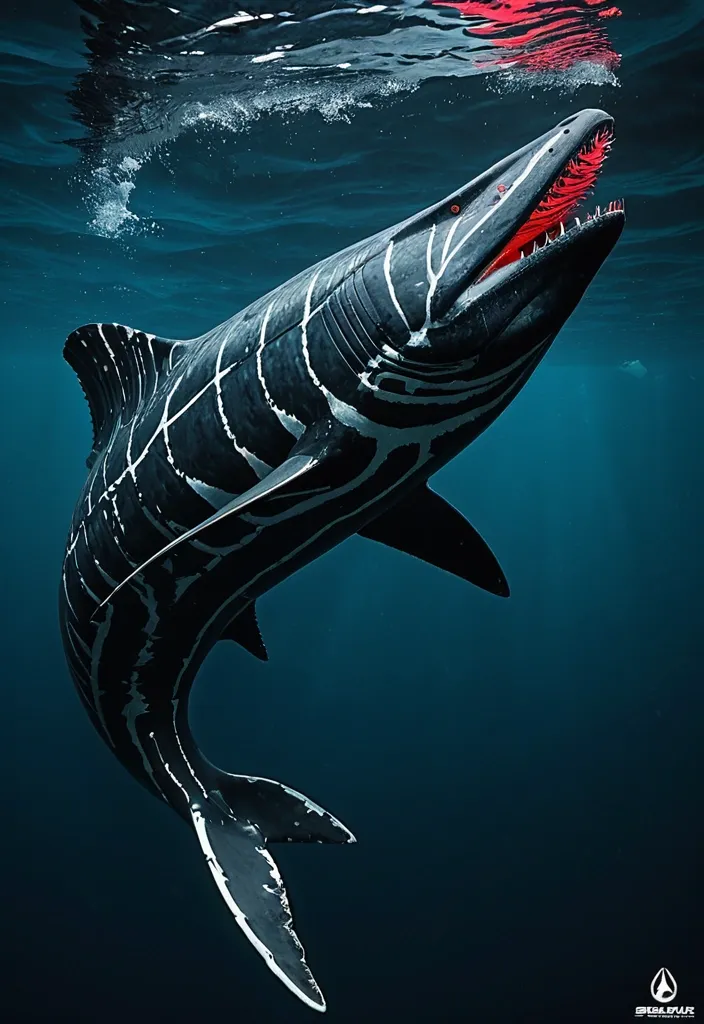
Physical Characteristics: Size & Weight: Between 40 to 60 feet in length , weighing 50 to 75 tons. Coloration: Males: Sleek black base with dark gray tiger stripes accented by subtle red bioluminescent highlights along the stripes , glowing faintly in deep ocean darkness. Females: Larger and more robust with black base and light gray tiger stripes , also featuring red bioluminescent patterns that pulse rhythmically. Body Structure: Hydrodynamic , muscular body combining the streamlined agility of the Shortfin Mako and Black Marlin with the robust power of Predator X and Megalodon. Rigid pectoral fins adapted from Black Marlin , capable of tilting back to reduce drag at high speeds. The tailend is a powerful fluke for propulsion , inspired by Mosasaurus Hoffmannii and Orca anatomy. Thick , overlapping bony scales similar to Arapaima , providing a durable armor that flexes with movement. Limbs: Powerful large flippers adapted for scooting or sliding on land , coated with mucus inspired by the Atlantic hagfish for moisture retention and defense. Capable of limited terrestrial movement , allowing brief excursions out of water. Head & Jaw: Massive jaws with over 40 , 000 PSI bite force , blending Predator X’s mighty jaw strength with the long canine teeth and powerful bite of the Leopard Seal. Flexible skull allowing swallowing of large prey whole. Respiration: Dual respiratory system with both functional lungs and gills , enabling survival from surface to abyssal depths (500 to 9 , 800 feet). Bioluminescence: Red bioluminescent photophores patterned in tiger stripes , used for communication , intimidation , mating displays , and luring prey in the dark ocean depths. Abilities & Traits: Speed & Agility: Capable of bursts up to 82 mph , rivaling the fastest sea creatures like the Black Marlin. Agile hunter using stealth and passive listening , mimicking Transient Killer Whale hunting strategies. Social Structure: Small family groups of three (one male , two females) designed for efficient reproduction and hunting. Males are more streamlined and shorter , optimized for speed and power; females are larger , robust , and agile for endurance and nurturing. Regeneration: Remarkable limb regeneration inspired by axolotl and Crown-of-Thorns starfish , able to regrow lost fins , limbs , and even parts of internal organs. Defense: Venomous spines derived from Crown-of-Thorns starfish line its dorsal ridge , delivering painful venomous wounds to attackers. Mucus coating for defense and moisture retention , also making it slippery and difficult to grasp. Healing: A blubber-like layer similar to dolphins provides insulation , buoyancy , and antimicrobial properties that accelerate healing of wounds. Communication: Uses low-frequency growls , barks , and hisses inspired by saltwater crocodile sounds , combined with bioluminescent signals and stealth vocalizations for hunting. Reproduction: Live births occur at extreme depths (up to 9 , 800 feet) , with offspring adapted to survive in crushing pressures and cold temperatures. Backstory: Created by the Ceno Evail Crossgen Corporation , the Megalosaurus Orca was engineered to dominate marine ecosystems and serve as a living testament to the pinnacle of hybrid dinosaur biotechnology. Designed to combine the raw power of ancient sea predators like Predator X and Megalodon with the intelligence , social hunting , and adaptability of modern marine mammals and fish , this hybrid thrives in the dark , cold depths of the ocean where few predators dare to venture. Their unique physiology allows them to traverse both deep ocean trenches and brief terrestrial environments , making them versatile apex predators. The three known individuals—one male and two females—form a tight-knit family unit , hunting elusive marine mammals and large fish with stealth and precision. Their bioluminescent stripes not only intimidate rivals but also help coordinate complex hunting maneuvers in pitch-black waters. With a lifespan of 100 to 135 years , they are long-lived titans of the sea , their legacy intertwined with the future of marine genetic engineering and the mysteries of oceanic evolution. , ,

The Megalosaurus Orca is a colossal marine hybrid dinosaur , measuring between 40 to 60 feet in length and weighing an astonishing 50 to 75 tons. Its body combines the robust , thick musculature and mighty jaw strength of Predator X and Megalodon with the sleek hydrodynamics and agility of the Mosasaurus Hoffmannii and transient killer whale. The creature’s skin is armored with large , overlapping bony scales inspired by the Arapaima , offering both flexibility and formidable protection against predators and environmental hazards. Its coloration is sexually dimorphic: males boast a deep black base coat adorned with light gray tiger stripes , while females display a gray base with stark white tiger stripes. Both sexes feature vivid red bioluminescent photophores arranged in tiger stripe patterns along their flanks and dorsal fins , used for communication , intimidation , mating displays , and luring prey in the abyssal darkness. The Megalosaurus Orca’s rigid pectoral fins can tilt back to reduce drag during high-speed pursuits , enabling bursts of speed up to 82 mph , rivaling the Black Marlin and shortfin mako shark. Powerful flippers , inspired by the leopard seal , allow it to scoot or slide short distances on land , useful for navigating beaches and shallow coasts. Its head features powerful jaws lined with dozens of large , long canine teeth capable of delivering over 40 , 000 PSI bite force , capable of crushing almost anything in its path. The skull is flexible , allowing it to swallow large prey whole. Crown-of-Thorns starfish-like venomous spines stud its dorsal ridge , serving as a defensive mechanism against attackers , and it can regenerate lost spines and limbs rapidly , a gift from its axolotl heritage. Abilities: Dual Respiratory System: Equipped with both functional lungs and gills , it can breathe underwater and survive brief excursions on land , as well as thrive at depths from 500 to 9 , 800 feet. Mucus Defense: Inspired by the Atlantic hagfish , it secretes a thick mucus layer that deters parasites and predators while retaining moisture during surface rests or land visits. Blubber Insulation: A thick layer of blubber provides thermal insulation , antimicrobial protection , and aids in rapid healing of wounds. The blubber’s varying stiffness across the body creates a springlike swimming motion , enhancing speed and agility. Stealth Hunting: Utilizing the transient killer whale’s passive listening abilities and silent movement , it stalks marine mammals and large prey with deadly precision , avoiding echolocation to remain undetected. Bioluminescent Communication: Red photophores allow complex signaling in the dark ocean depths for social interaction , mating , and intimidation. Salinity Tolerance: Can thrive in a wide range of salinity levels , from freshwater estuaries to the deep ocean , thanks to genetic traits from Mexican molly and saltwater crocodile. Reproductive Strategy: Live births occur in crushing-pressure depths up to 9 , 800 feet. Offspring are born adapted to extreme cold and pressure. The social group consists of a male and two females , balancing speed/power and endurance/nurturing roles. Behavior and Social Structure: Megalosaurus Orca travel in small , tight-knit family units of three , mirroring the transient killer whale’s social structure. The male leads high-speed hunts , using brute force and stealth , while females provide endurance and care for offspring. They communicate through low growls , barks , and the flashing of their bioluminescent stripes. Backstory: Created by the Ceno Evail Crossgen Corporation , the Megalosaurus Orca was engineered as the ultimate marine apex predator and survivor , blending the most fearsome traits of prehistoric and modern oceanic hunters. Designed to dominate both shallow and abyssal waters , it represents a pinnacle of genetic engineering with a lifespan reaching up to 135 years. Its creation was part of a secret project to explore deep-sea resource harvesting and marine ecosystem control , but its intelligence and adaptability have made it a subject of fascination and caution among researchers. ,

The Megalosaurus Orca is a colossal marine hybrid dinosaur , measuring between 40 to 60 feet in length and weighing an astonishing 50 to 75 tons. Its body combines the robust , thick musculature and mighty jaw strength of Predator X and Megalodon with the sleek hydrodynamics and agility of the Mosasaurus Hoffmannii and transient killer whale. The creature’s skin is armored with large , overlapping bony scales inspired by the Arapaima , offering both flexibility and formidable protection against predators and environmental hazards. Its coloration is sexually dimorphic: males boast a deep black base coat adorned with light gray tiger stripes , while females display a gray base with stark white tiger stripes. Both sexes feature vivid red bioluminescent photophores arranged in tiger stripe patterns along their flanks and dorsal fins , used for communication , intimidation , mating displays , and luring prey in the abyssal darkness. The Megalosaurus Orca’s rigid pectoral fins can tilt back to reduce drag during high-speed pursuits , enabling bursts of speed up to 82 mph , rivaling the Black Marlin and shortfin mako shark. Powerful flippers , inspired by the leopard seal , allow it to scoot or slide short distances on land , useful for navigating beaches and shallow coasts. Its head features powerful jaws lined with dozens of large , long canine teeth capable of delivering over 40 , 000 PSI bite force , capable of crushing almost anything in its path. The skull is flexible , allowing it to swallow large prey whole. Crown-of-Thorns starfish-like venomous spines stud its dorsal ridge , serving as a defensive mechanism against attackers , and it can regenerate lost spines and limbs rapidly , a gift from its axolotl heritage. Abilities: Dual Respiratory System: Equipped with both functional lungs and gills , it can breathe underwater and survive brief excursions on land , as well as thrive at depths from 500 to 9 , 800 feet. Mucus Defense: Inspired by the Atlantic hagfish , it secretes a thick mucus layer that deters parasites and predators while retaining moisture during surface rests or land visits. Blubber Insulation: A thick layer of blubber provides thermal insulation , antimicrobial protection , and aids in rapid healing of wounds. The blubber’s varying stiffness across the body creates a springlike swimming motion , enhancing speed and agility. Stealth Hunting: Utilizing the transient killer whale’s passive listening abilities and silent movement , it stalks marine mammals and large prey with deadly precision , avoiding echolocation to remain undetected. Bioluminescent Communication: Red photophores allow complex signaling in the dark ocean depths for social interaction , mating , and intimidation. Salinity Tolerance: Can thrive in a wide range of salinity levels , from freshwater estuaries to the deep ocean , thanks to genetic traits from Mexican molly and saltwater crocodile. Reproductive Strategy: Live births occur in crushing-pressure depths up to 9 , 800 feet. Offspring are born adapted to extreme cold and pressure. The social group consists of a male and two females , balancing speed/power and endurance/nurturing roles. Behavior and Social Structure: Megalosaurus Orca travel in small , tight-knit family units of three , mirroring the transient killer whale’s social structure. The male leads high-speed hunts , using brute force and stealth , while females provide endurance and care for offspring. They communicate through low growls , barks , and the flashing of their bioluminescent stripes. Backstory: Created by the Ceno Evail Crossgen Corporation , the Megalosaurus Orca was engineered as the ultimate marine apex predator and survivor , blending the most fearsome traits of prehistoric and modern oceanic hunters. Designed to dominate both shallow and abyssal waters , it represents a pinnacle of genetic engineering with a lifespan reaching up to 135 years. Its creation was part of a secret project to explore deep-sea resource harvesting and marine ecosystem control , but its intelligence and adaptability have made it a subject of fascination and caution among researchers. ,

Physical Characteristics: Size & Weight: Between 40 to 60 feet in length , weighing 50 to 75 tons. Coloration: Males: Sleek black base with dark gray tiger stripes accented by subtle red bioluminescent highlights along the stripes , glowing faintly in deep ocean darkness. Females: Larger and more robust with black base and light gray tiger stripes , also featuring red bioluminescent patterns that pulse rhythmically. Body Structure: Hydrodynamic , muscular body combining the streamlined agility of the Shortfin Mako and Black Marlin with the robust power of Predator X and Megalodon. Rigid pectoral fins adapted from Black Marlin , capable of tilting back to reduce drag at high speeds. The tailend is a powerful fluke for propulsion , inspired by Mosasaurus Hoffmannii and Orca anatomy. Thick , overlapping bony scales similar to Arapaima , providing a durable armor that flexes with movement. Limbs: Powerful large flippers adapted for scooting or sliding on land , coated with mucus inspired by the Atlantic hagfish for moisture retention and defense. Capable of limited terrestrial movement , allowing brief excursions out of water. Head & Jaw: Massive jaws with over 40 , 000 PSI bite force , blending Predator X’s mighty jaw strength with the long canine teeth and powerful bite of the Leopard Seal. Flexible skull allowing swallowing of large prey whole. Respiration: Dual respiratory system with both functional lungs and gills , enabling survival from surface to abyssal depths (500 to 9 , 800 feet). Bioluminescence: Red bioluminescent photophores patterned in tiger stripes , used for communication , intimidation , mating displays , and luring prey in the dark ocean depths. Abilities & Traits: Speed & Agility: Capable of bursts up to 82 mph , rivaling the fastest sea creatures like the Black Marlin. Agile hunter using stealth and passive listening , mimicking Transient Killer Whale hunting strategies. Social Structure: Small family groups of three (one male , two females) designed for efficient reproduction and hunting. Males are more streamlined and shorter , optimized for speed and power; females are larger , robust , and agile for endurance and nurturing. Regeneration: Remarkable limb regeneration inspired by axolotl and Crown-of-Thorns starfish , able to regrow lost fins , limbs , and even parts of internal organs. Defense: Venomous spines derived from Crown-of-Thorns starfish line its dorsal ridge , delivering painful venomous wounds to attackers. Mucus coating for defense and moisture retention , also making it slippery and difficult to grasp. Healing: A blubber-like layer similar to dolphins provides insulation , buoyancy , and antimicrobial properties that accelerate healing of wounds. Communication: Uses low-frequency growls , barks , and hisses inspired by saltwater crocodile sounds , combined with bioluminescent signals and stealth vocalizations for hunting. Reproduction: Live births occur at extreme depths (up to 9 , 800 feet) , with offspring adapted to survive in crushing pressures and cold temperatures. Backstory: Created by the Ceno Evail Crossgen Corporation , the Megalosaurus Orca was engineered to dominate marine ecosystems and serve as a living testament to the pinnacle of hybrid dinosaur biotechnology. Designed to combine the raw power of ancient sea predators like Predator X and Megalodon with the intelligence , social hunting , and adaptability of modern marine mammals and fish , this hybrid thrives in the dark , cold depths of the ocean where few predators dare to venture. Their unique physiology allows them to traverse both deep ocean trenches and brief terrestrial environments , making them versatile apex predators. The three known individuals—one male and two females—form a tight-knit family unit , hunting elusive marine mammals and large fish with stealth and precision. Their bioluminescent stripes not only intimidate rivals but also help coordinate complex hunting maneuvers in pitch-black waters. With a lifespan of 100 to 135 years , they are long-lived titans of the sea , their legacy intertwined with the future of marine genetic engineering and the mysteries of oceanic evolution. ,

breathtaking bird eye view , realistic , ultra-derailleur , high resolution , lighting like a movie , artificial intelligence , above the space , a Panopticon 3D sculpture of an abstract Cylinder in air , made from various elements such as buildings and trees is formed with hundreds of stars , motion speed , all combined to create the shape of a UFO. The background is neutral with soft lighting , creating a mysterious atmosphere. ,

Artificial intelligence , above the space , a surrealistic 3D sculpture of an abstract Cylinder in air , made from various elements such as buildings and trees is formed with hundreds of stars , motion speed , Falling stars illuminate the sky , all combined to create the shape of a UFO. The background is neutral with soft lighting , creating a mysterious atmosphere. twinkling below , gentle gradient night sky , ,

Artificial intelligence , above the cityscape , A surrealistic sculpture of an abstract earth in air , made from various elements such as buildings and trees , all combined to create the shape of a earth. The background is neutral with soft lighting , creating a mysterious atmosphere. city lights twinkling below , gentle gradient dusk sky , electricity and data flow through tubes in vast landscape of the internet ,

A breathtaking portrait of a young , intelligent woman radiates joy as she smiles softly , her long , flowing nymph-style dress draping elegantly around her. The dress , intricately designed with translucent layers , gently catches the warm , golden rays of a natural sundown , casting a soft glow that highlights her detailed skin. Her luxurious brunette hair cascades in gentle waves , framing her face with an air of ethereal beauty. The background is an idyllic landscape kissed by the sun's last light , with vibrant hues of oranges and pinks blending seamlessly into a tranquil sky. This high detail RAW color photo captures every nuance , emphasizing the interplay of light and shadow on her serene expression , evoking a sense of harmony and enchantment. ,

Masterpiece: Doorway floating in ocean at sunset , its frame: Left pillar: Stacked ethical tech devices (#EthicalTech logos) Right pillar: Community garden harvest baskets Lintel: Flowing Sanskrit from "Zeit – Der Schlüssel" (K. Parvathi Kumar) , through the door: Berlin's Museum Island glowing with golden light , style: magical realism architecture , terracotta/gold/azure , aspect ratio: 21:9 --s 800 ,

Doorway floating in ocean at sunset , its frame: Left pillar: Stacked ethical tech devices (#EthicalTech logos) Right pillar: Community garden harvest baskets Lintel: Flowing Sanskrit from "Zeit – Der Schlüssel" (K. Parvathi Kumar) , through the door: Berlin's Museum Island glowing with golden light , style: magical realism architecture , terracotta/gold/azure , aspect ratio: 21:9 --s 800 ,
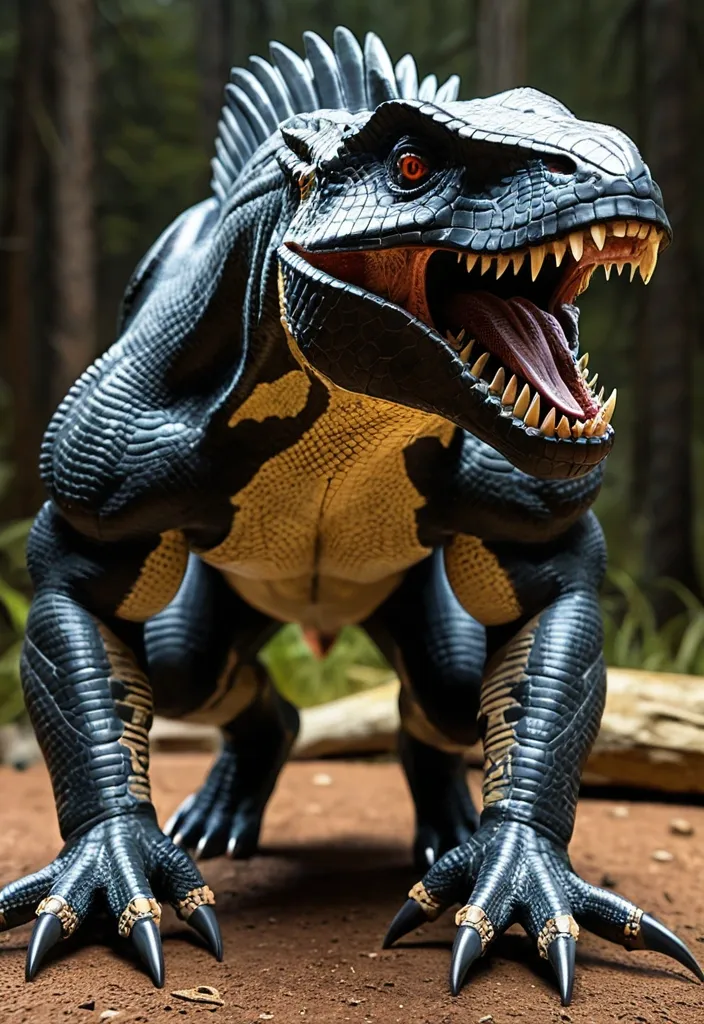
Physical Characteristics: Size & Build: Towering at around 15 feet tall and 40 feet long , Venenosus Rex exhibits a robust , muscular build with bulky , reduced hind legs adapted for powerful knuckle-walking quadrupedal locomotion , inherited from its Ape DNA. Its stance is low and intimidating , allowing swift bursts of speed and stability. Head: The head is a terrifying blend of Tyrannosaurus rex , Giganotosaurus , and Triceratops shapes—a broad , armored skull with a reinforced bony frill and horn-like protrusions from Triceratops , providing natural defense. Its jaw can open up to 90 degrees , snake-like , capable of delivering crushing bites able to shatter bulletproof glass. Skin & Camouflage: Covered in thick , overlapping Scelidosaurus-like osteoderm armor plates along the back and flanks , providing excellent protection against attacks. The skin contains chromatophore cells from cuttlefish DNA , allowing Venenosus Rex to dynamically change skin color , texture , and pattern for camouflage or intimidation. Arms & Claws: Long , powerful arms inspired by Saurophaganax and Ape DNA end in razor-sharp , hooked claws capable of slashing through armored prey and wielding tools for complex hunting strategies. Teeth & Fangs: Teeth are a deadly combination from the Inland Taipan’s retractable fangs , Komodo Dragon’s serrated teeth , and Northern short-tailed shrew’s sharp incisors , allowing it to pierce armor and inject highly toxic saliva into prey. Eyes & Senses: Equipped with specialized cranial cavities housing infrared vision , enabling night hunting and detection of body heat signatures. Its olfactory and auditory senses are exceptionally refined due to Utahraptor and Komodo Dragon ancestry. Unique Abilities: Extreme Environmental Resistance: Thanks to Tardigrade , Opossum , and Mongoose DNA , Venenosus Rex can survive extreme temperatures , radiation , dehydration , starvation , and bacterial infections. Its organs are shielded by trehalose gel , and its DNA is protected by specialized proteins against radiation damage. It can slow its metabolism down to 0.01% of normal , entering a near-hibernative state during harsh conditions. Toxic Saliva & Venom: Its saliva contains potent neurotoxins and anticoagulants , ensuring even minor bites are deadly over time. Combined with its retractable fangs , it can efficiently incapacitate prey or rivals. Camouflage & Stealth: Dynamic skin color and texture changes allow it to blend seamlessly into diverse environments or mimic threatening patterns to intimidate. Intelligence & Pack Hunting: Enhanced Utahraptor DNA grants high cognitive abilities , including planning , problem-solving , and social pack hunting tactics , making it a highly strategic predator. Tool Use: The combination of long , dexterous arms and ape DNA allows it to manipulate objects , set traps , or use environmental tools during hunts. Wide Jaw Opening: The ability to open its jaw at a 90-degree angle allows for impressive bite range and prey handling , intimidating foes with sudden wide gapes. ,
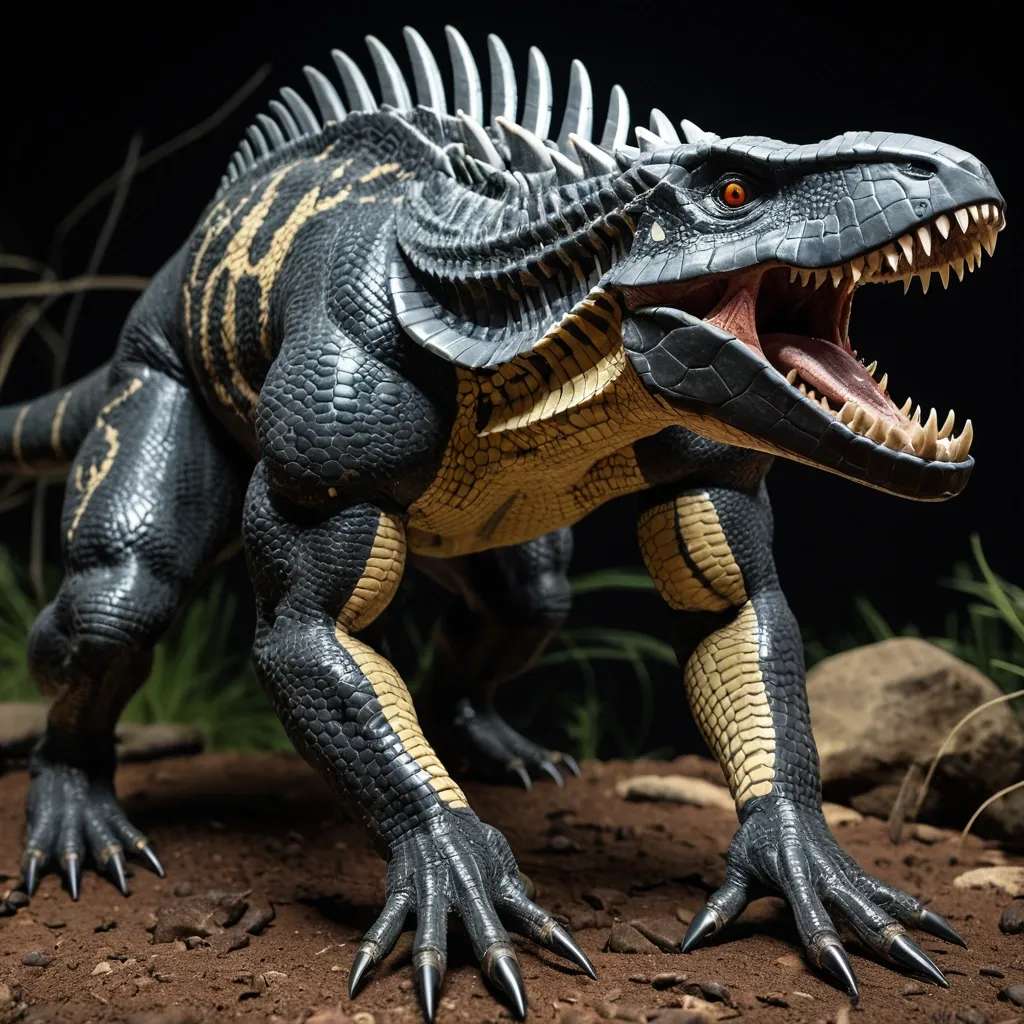
Physical Characteristics: Size & Build: Towering at around 15 feet tall and 40 feet long , Venenosus Rex exhibits a robust , muscular build with bulky , reduced hind legs adapted for powerful knuckle-walking quadrupedal locomotion , inherited from its Ape DNA. Its stance is low and intimidating , allowing swift bursts of speed and stability. Head: The head is a terrifying blend of Tyrannosaurus rex , Giganotosaurus , and Triceratops shapes—a broad , armored skull with a reinforced bony frill and horn-like protrusions from Triceratops , providing natural defense. Its jaw can open up to 90 degrees , snake-like , capable of delivering crushing bites able to shatter bulletproof glass. Skin & Camouflage: Covered in thick , overlapping Scelidosaurus-like osteoderm armor plates along the back and flanks , providing excellent protection against attacks. The skin contains chromatophore cells from cuttlefish DNA , allowing Venenosus Rex to dynamically change skin color , texture , and pattern for camouflage or intimidation. Arms & Claws: Long , powerful arms inspired by Saurophaganax and Ape DNA end in razor-sharp , hooked claws capable of slashing through armored prey and wielding tools for complex hunting strategies. Teeth & Fangs: Teeth are a deadly combination from the Inland Taipan’s retractable fangs , Komodo Dragon’s serrated teeth , and Northern short-tailed shrew’s sharp incisors , allowing it to pierce armor and inject highly toxic saliva into prey. Eyes & Senses: Equipped with specialized cranial cavities housing infrared vision , enabling night hunting and detection of body heat signatures. Its olfactory and auditory senses are exceptionally refined due to Utahraptor and Komodo Dragon ancestry. Unique Abilities: Extreme Environmental Resistance: Thanks to Tardigrade , Opossum , and Mongoose DNA , Venenosus Rex can survive extreme temperatures , radiation , dehydration , starvation , and bacterial infections. Its organs are shielded by trehalose gel , and its DNA is protected by specialized proteins against radiation damage. It can slow its metabolism down to 0.01% of normal , entering a near-hibernative state during harsh conditions. Toxic Saliva & Venom: Its saliva contains potent neurotoxins and anticoagulants , ensuring even minor bites are deadly over time. Combined with its retractable fangs , it can efficiently incapacitate prey or rivals. Camouflage & Stealth: Dynamic skin color and texture changes allow it to blend seamlessly into diverse environments or mimic threatening patterns to intimidate. Intelligence & Pack Hunting: Enhanced Utahraptor DNA grants high cognitive abilities , including planning , problem-solving , and social pack hunting tactics , making it a highly strategic predator. Tool Use: The combination of long , dexterous arms and ape DNA allows it to manipulate objects , set traps , or use environmental tools during hunts. Wide Jaw Opening: The ability to open its jaw at a 90-degree angle allows for impressive bite range and prey handling , intimidating foes with sudden wide gapes. ,
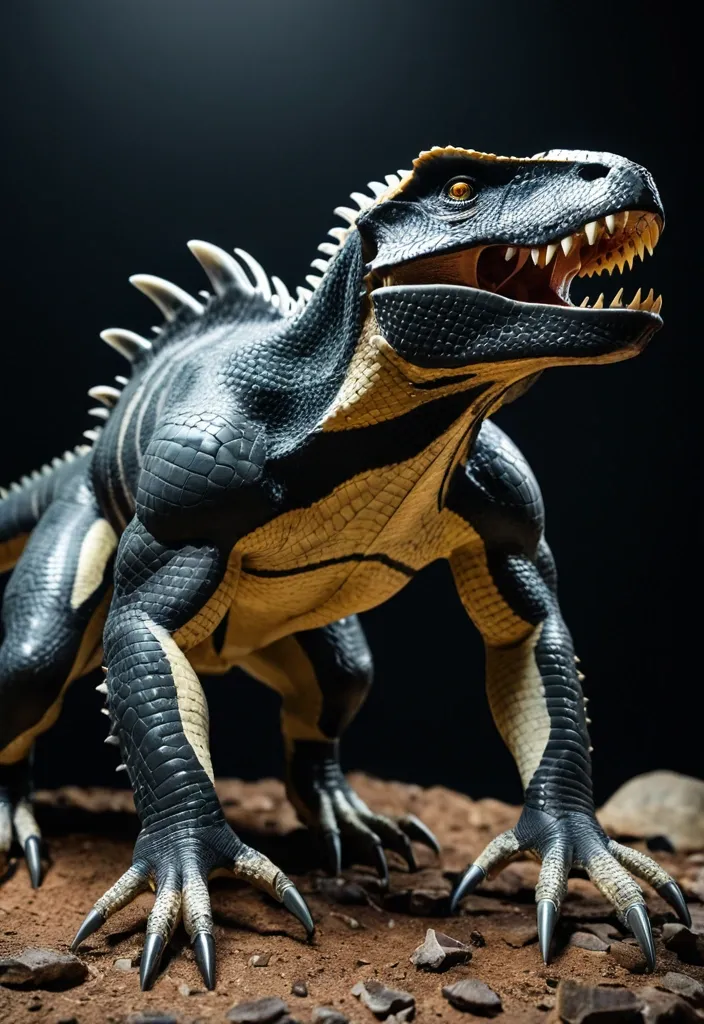
Physical Characteristics: Size & Build: Towering at around 15 feet tall and 40 feet long , Venenosus Rex exhibits a robust , muscular build with bulky , reduced hind legs adapted for powerful knuckle-walking quadrupedal locomotion , inherited from its Ape DNA. Its stance is low and intimidating , allowing swift bursts of speed and stability. Head: The head is a terrifying blend of Tyrannosaurus rex , Giganotosaurus , and Triceratops shapes—a broad , armored skull with a reinforced bony frill and horn-like protrusions from Triceratops , providing natural defense. Its jaw can open up to 90 degrees , snake-like , capable of delivering crushing bites able to shatter bulletproof glass. Skin & Camouflage: Covered in thick , overlapping Scelidosaurus-like osteoderm armor plates along the back and flanks , providing excellent protection against attacks. The skin contains chromatophore cells from cuttlefish DNA , allowing Venenosus Rex to dynamically change skin color , texture , and pattern for camouflage or intimidation. Arms & Claws: Long , powerful arms inspired by Saurophaganax and Ape DNA end in razor-sharp , hooked claws capable of slashing through armored prey and wielding tools for complex hunting strategies. Teeth & Fangs: Teeth are a deadly combination from the Inland Taipan’s retractable fangs , Komodo Dragon’s serrated teeth , and Northern short-tailed shrew’s sharp incisors , allowing it to pierce armor and inject highly toxic saliva into prey. Eyes & Senses: Equipped with specialized cranial cavities housing infrared vision , enabling night hunting and detection of body heat signatures. Its olfactory and auditory senses are exceptionally refined due to Utahraptor and Komodo Dragon ancestry. Unique Abilities: Extreme Environmental Resistance: Thanks to Tardigrade , Opossum , and Mongoose DNA , Venenosus Rex can survive extreme temperatures , radiation , dehydration , starvation , and bacterial infections. Its organs are shielded by trehalose gel , and its DNA is protected by specialized proteins against radiation damage. It can slow its metabolism down to 0.01% of normal , entering a near-hibernative state during harsh conditions. Toxic Saliva & Venom: Its saliva contains potent neurotoxins and anticoagulants , ensuring even minor bites are deadly over time. Combined with its retractable fangs , it can efficiently incapacitate prey or rivals. Camouflage & Stealth: Dynamic skin color and texture changes allow it to blend seamlessly into diverse environments or mimic threatening patterns to intimidate. Intelligence & Pack Hunting: Enhanced Utahraptor DNA grants high cognitive abilities , including planning , problem-solving , and social pack hunting tactics , making it a highly strategic predator. Tool Use: The combination of long , dexterous arms and ape DNA allows it to manipulate objects , set traps , or use environmental tools during hunts. Wide Jaw Opening: The ability to open its jaw at a 90-degree angle allows for impressive bite range and prey handling , intimidating foes with sudden wide gapes. ,
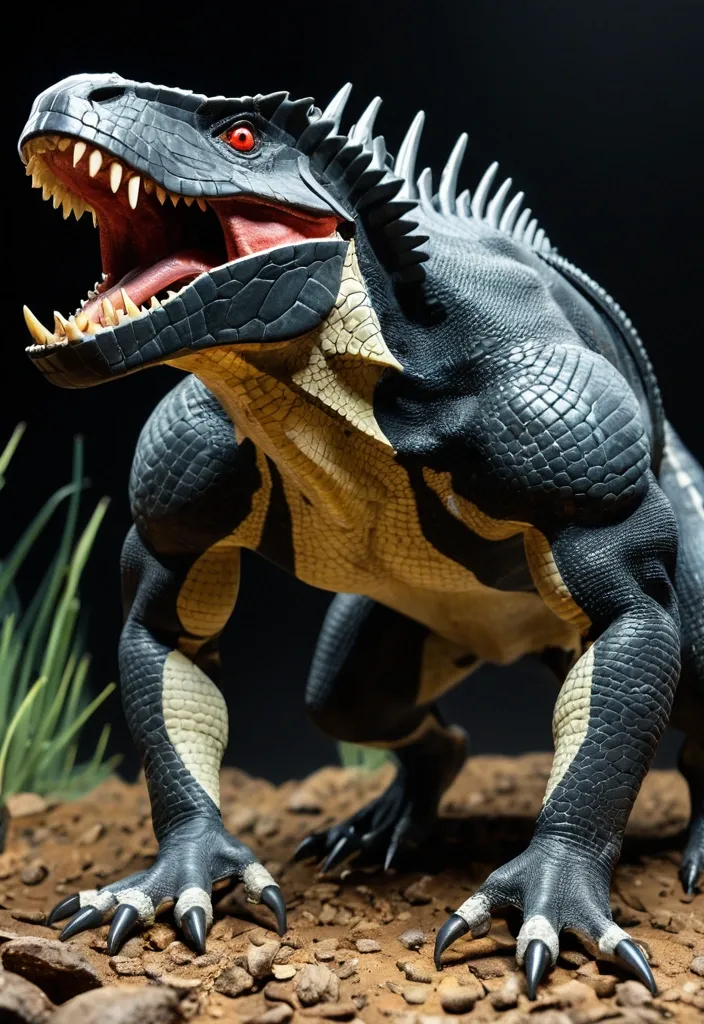
Physical Characteristics: Size & Build: Towering at around 15 feet tall and 40 feet long , Venenosus Rex exhibits a robust , muscular build with bulky , reduced hind legs adapted for powerful knuckle-walking quadrupedal locomotion , inherited from its Ape DNA. Its stance is low and intimidating , allowing swift bursts of speed and stability. Head: The head is a terrifying blend of Tyrannosaurus rex , Giganotosaurus , and Triceratops shapes—a broad , armored skull with a reinforced bony frill and horn-like protrusions from Triceratops , providing natural defense. Its jaw can open up to 90 degrees , snake-like , capable of delivering crushing bites able to shatter bulletproof glass. Skin & Camouflage: Covered in thick , overlapping Scelidosaurus-like osteoderm armor plates along the back and flanks , providing excellent protection against attacks. The skin contains chromatophore cells from cuttlefish DNA , allowing Venenosus Rex to dynamically change skin color , texture , and pattern for camouflage or intimidation. Arms & Claws: Long , powerful arms inspired by Saurophaganax and Ape DNA end in razor-sharp , hooked claws capable of slashing through armored prey and wielding tools for complex hunting strategies. Teeth & Fangs: Teeth are a deadly combination from the Inland Taipan’s retractable fangs , Komodo Dragon’s serrated teeth , and Northern short-tailed shrew’s sharp incisors , allowing it to pierce armor and inject highly toxic saliva into prey. Eyes & Senses: Equipped with specialized cranial cavities housing infrared vision , enabling night hunting and detection of body heat signatures. Its olfactory and auditory senses are exceptionally refined due to Utahraptor and Komodo Dragon ancestry. Unique Abilities: Extreme Environmental Resistance: Thanks to Tardigrade , Opossum , and Mongoose DNA , Venenosus Rex can survive extreme temperatures , radiation , dehydration , starvation , and bacterial infections. Its organs are shielded by trehalose gel , and its DNA is protected by specialized proteins against radiation damage. It can slow its metabolism down to 0.01% of normal , entering a near-hibernative state during harsh conditions. Toxic Saliva & Venom: Its saliva contains potent neurotoxins and anticoagulants , ensuring even minor bites are deadly over time. Combined with its retractable fangs , it can efficiently incapacitate prey or rivals. Camouflage & Stealth: Dynamic skin color and texture changes allow it to blend seamlessly into diverse environments or mimic threatening patterns to intimidate. Intelligence & Pack Hunting: Enhanced Utahraptor DNA grants high cognitive abilities , including planning , problem-solving , and social pack hunting tactics , making it a highly strategic predator. Tool Use: The combination of long , dexterous arms and ape DNA allows it to manipulate objects , set traps , or use environmental tools during hunts. Wide Jaw Opening: The ability to open its jaw at a 90-degree angle allows for impressive bite range and prey handling , intimidating foes with sudden wide gapes. ,
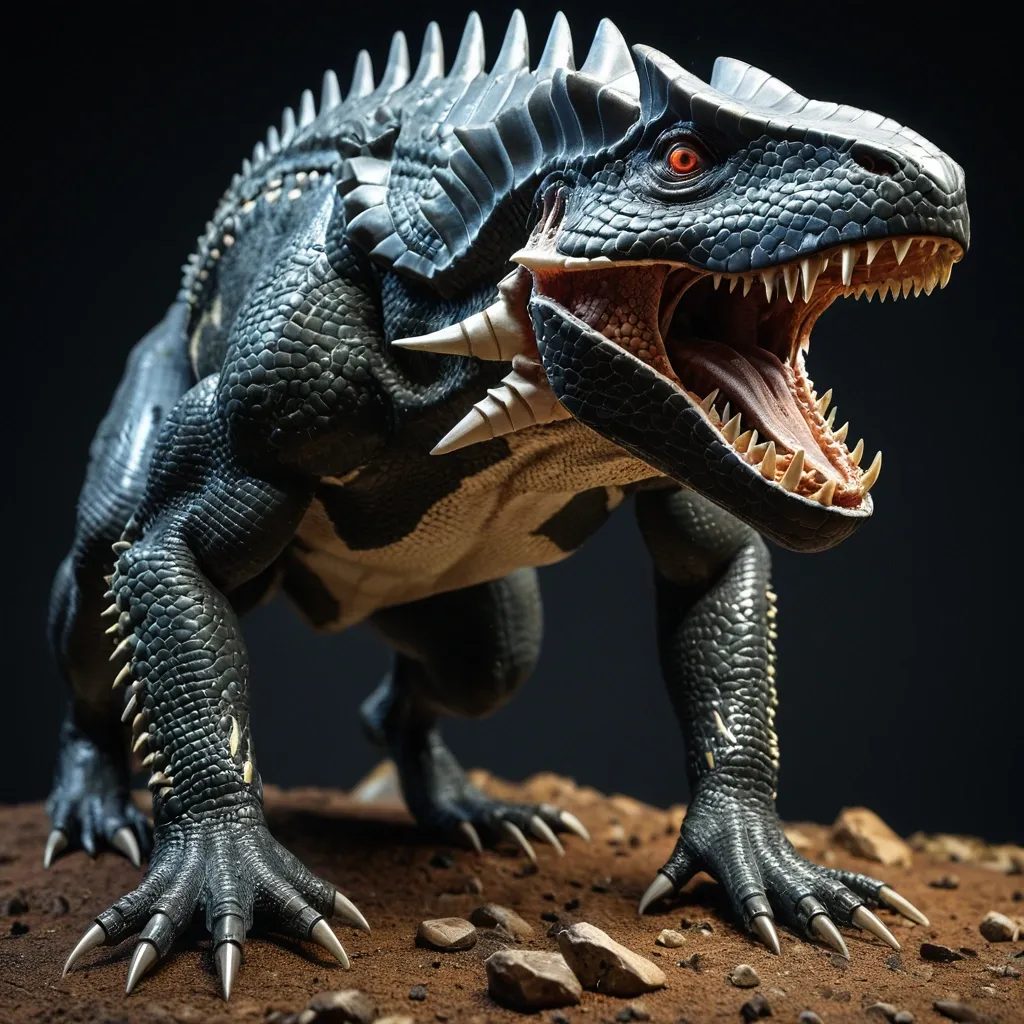
Physical Characteristics: Size & Build: Towering at around 15 feet tall and 40 feet long , Venenosus Rex exhibits a robust , muscular build with bulky , reduced hind legs adapted for powerful knuckle-walking quadrupedal locomotion , inherited from its Ape DNA. Its stance is low and intimidating , allowing swift bursts of speed and stability. Head: The head is a terrifying blend of Tyrannosaurus rex , Giganotosaurus , and Triceratops shapes—a broad , armored skull with a reinforced bony frill and horn-like protrusions from Triceratops , providing natural defense. Its jaw can open up to 90 degrees , snake-like , capable of delivering crushing bites able to shatter bulletproof glass. Skin & Camouflage: Covered in thick , overlapping Scelidosaurus-like osteoderm armor plates along the back and flanks , providing excellent protection against attacks. The skin contains chromatophore cells from cuttlefish DNA , allowing Venenosus Rex to dynamically change skin color , texture , and pattern for camouflage or intimidation. Arms & Claws: Long , powerful arms inspired by Saurophaganax and Ape DNA end in razor-sharp , hooked claws capable of slashing through armored prey and wielding tools for complex hunting strategies. Teeth & Fangs: Teeth are a deadly combination from the Inland Taipan’s retractable fangs , Komodo Dragon’s serrated teeth , and Northern short-tailed shrew’s sharp incisors , allowing it to pierce armor and inject highly toxic saliva into prey. Eyes & Senses: Equipped with specialized cranial cavities housing infrared vision , enabling night hunting and detection of body heat signatures. Its olfactory and auditory senses are exceptionally refined due to Utahraptor and Komodo Dragon ancestry. Unique Abilities: Extreme Environmental Resistance: Thanks to Tardigrade , Opossum , and Mongoose DNA , Venenosus Rex can survive extreme temperatures , radiation , dehydration , starvation , and bacterial infections. Its organs are shielded by trehalose gel , and its DNA is protected by specialized proteins against radiation damage. It can slow its metabolism down to 0.01% of normal , entering a near-hibernative state during harsh conditions. Toxic Saliva & Venom: Its saliva contains potent neurotoxins and anticoagulants , ensuring even minor bites are deadly over time. Combined with its retractable fangs , it can efficiently incapacitate prey or rivals. Camouflage & Stealth: Dynamic skin color and texture changes allow it to blend seamlessly into diverse environments or mimic threatening patterns to intimidate. Intelligence & Pack Hunting: Enhanced Utahraptor DNA grants high cognitive abilities , including planning , problem-solving , and social pack hunting tactics , making it a highly strategic predator. Tool Use: The combination of long , dexterous arms and ape DNA allows it to manipulate objects , set traps , or use environmental tools during hunts. Wide Jaw Opening: The ability to open its jaw at a 90-degree angle allows for impressive bite range and prey handling , intimidating foes with sudden wide gapes. ,
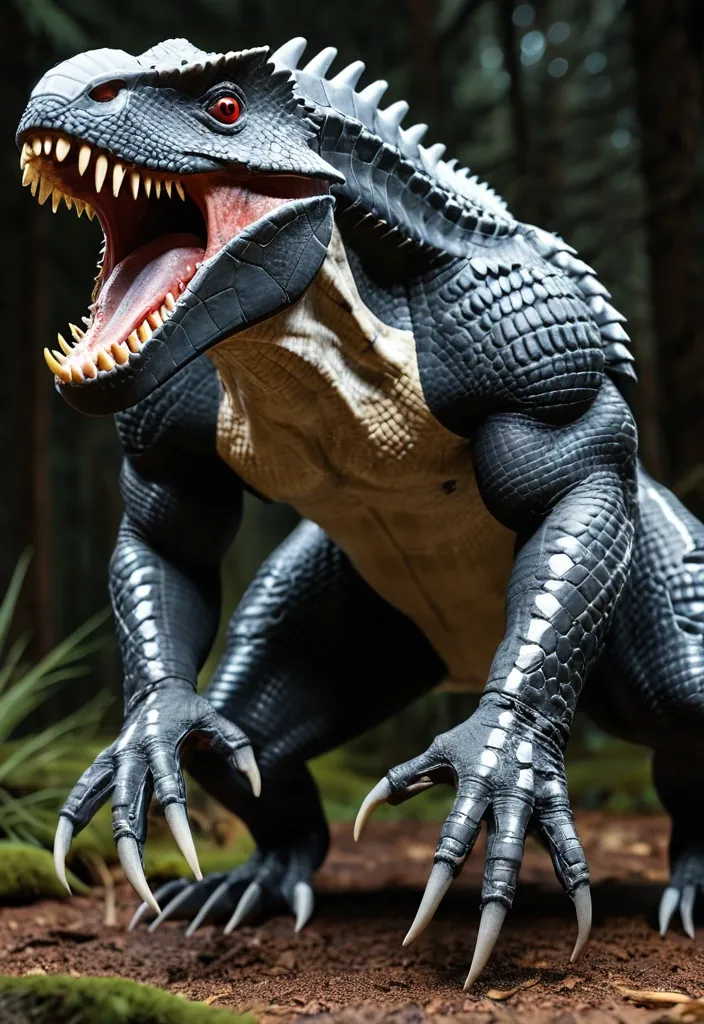
Physical Characteristics: Size & Build: Towering at around 15 feet tall and 40 feet long , Venenosus Rex exhibits a robust , muscular build with bulky , reduced hind legs adapted for powerful knuckle-walking quadrupedal locomotion , inherited from its Ape DNA. Its stance is low and intimidating , allowing swift bursts of speed and stability. Head: The head is a terrifying blend of Tyrannosaurus rex , Giganotosaurus , and Triceratops shapes—a broad , armored skull with a reinforced bony frill and horn-like protrusions from Triceratops , providing natural defense. Its jaw can open up to 90 degrees , snake-like , capable of delivering crushing bites able to shatter bulletproof glass. Skin & Camouflage: Covered in thick , overlapping Scelidosaurus-like osteoderm armor plates along the back and flanks , providing excellent protection against attacks. The skin contains chromatophore cells from cuttlefish DNA , allowing Venenosus Rex to dynamically change skin color , texture , and pattern for camouflage or intimidation. Arms & Claws: Long , powerful arms inspired by Saurophaganax and Ape DNA end in razor-sharp , hooked claws capable of slashing through armored prey and wielding tools for complex hunting strategies. Teeth & Fangs: Teeth are a deadly combination from the Inland Taipan’s retractable fangs , Komodo Dragon’s serrated teeth , and Northern short-tailed shrew’s sharp incisors , allowing it to pierce armor and inject highly toxic saliva into prey. Eyes & Senses: Equipped with specialized cranial cavities housing infrared vision , enabling night hunting and detection of body heat signatures. Its olfactory and auditory senses are exceptionally refined due to Utahraptor and Komodo Dragon ancestry. Unique Abilities: Extreme Environmental Resistance: Thanks to Tardigrade , Opossum , and Mongoose DNA , Venenosus Rex can survive extreme temperatures , radiation , dehydration , starvation , and bacterial infections. Its organs are shielded by trehalose gel , and its DNA is protected by specialized proteins against radiation damage. It can slow its metabolism down to 0.01% of normal , entering a near-hibernative state during harsh conditions. Toxic Saliva & Venom: Its saliva contains potent neurotoxins and anticoagulants , ensuring even minor bites are deadly over time. Combined with its retractable fangs , it can efficiently incapacitate prey or rivals. Camouflage & Stealth: Dynamic skin color and texture changes allow it to blend seamlessly into diverse environments or mimic threatening patterns to intimidate. Intelligence & Pack Hunting: Enhanced Utahraptor DNA grants high cognitive abilities , including planning , problem-solving , and social pack hunting tactics , making it a highly strategic predator. Tool Use: The combination of long , dexterous arms and ape DNA allows it to manipulate objects , set traps , or use environmental tools during hunts. Wide Jaw Opening: The ability to open its jaw at a 90-degree angle allows for impressive bite range and prey handling , intimidating foes with sudden wide gapes. ,
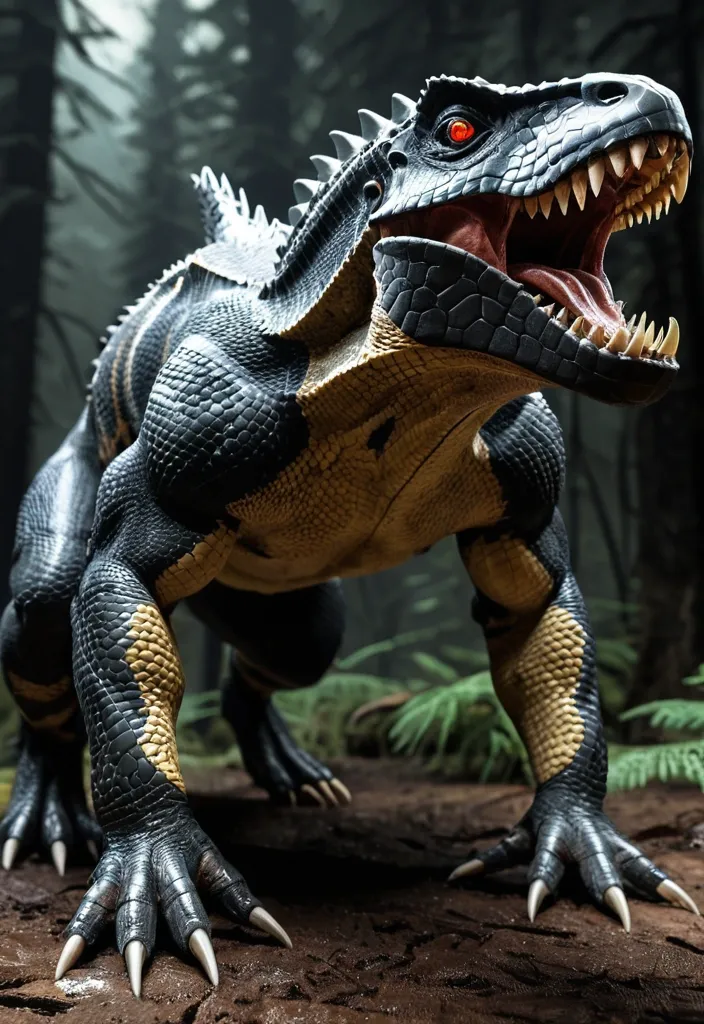
Physical Characteristics: Size & Build: Towering at around 15 feet tall and 40 feet long , Venenosus Rex exhibits a robust , muscular build with bulky , reduced hind legs adapted for powerful knuckle-walking quadrupedal locomotion , inherited from its Ape DNA. Its stance is low and intimidating , allowing swift bursts of speed and stability. Head: The head is a terrifying blend of Tyrannosaurus rex , Giganotosaurus , and Triceratops shapes—a broad , armored skull with a reinforced bony frill and horn-like protrusions from Triceratops , providing natural defense. Its jaw can open up to 90 degrees , snake-like , capable of delivering crushing bites able to shatter bulletproof glass. Skin & Camouflage: Covered in thick , overlapping Scelidosaurus-like osteoderm armor plates along the back and flanks , providing excellent protection against attacks. The skin contains chromatophore cells from cuttlefish DNA , allowing Venenosus Rex to dynamically change skin color , texture , and pattern for camouflage or intimidation. Arms & Claws: Long , powerful arms inspired by Saurophaganax and Ape DNA end in razor-sharp , hooked claws capable of slashing through armored prey and wielding tools for complex hunting strategies. Teeth & Fangs: Teeth are a deadly combination from the Inland Taipan’s retractable fangs , Komodo Dragon’s serrated teeth , and Northern short-tailed shrew’s sharp incisors , allowing it to pierce armor and inject highly toxic saliva into prey. Eyes & Senses: Equipped with specialized cranial cavities housing infrared vision , enabling night hunting and detection of body heat signatures. Its olfactory and auditory senses are exceptionally refined due to Utahraptor and Komodo Dragon ancestry. Unique Abilities: Extreme Environmental Resistance: Thanks to Tardigrade , Opossum , and Mongoose DNA , Venenosus Rex can survive extreme temperatures , radiation , dehydration , starvation , and bacterial infections. Its organs are shielded by trehalose gel , and its DNA is protected by specialized proteins against radiation damage. It can slow its metabolism down to 0.01% of normal , entering a near-hibernative state during harsh conditions. Toxic Saliva & Venom: Its saliva contains potent neurotoxins and anticoagulants , ensuring even minor bites are deadly over time. Combined with its retractable fangs , it can efficiently incapacitate prey or rivals. Camouflage & Stealth: Dynamic skin color and texture changes allow it to blend seamlessly into diverse environments or mimic threatening patterns to intimidate. Intelligence & Pack Hunting: Enhanced Utahraptor DNA grants high cognitive abilities , including planning , problem-solving , and social pack hunting tactics , making it a highly strategic predator. Tool Use: The combination of long , dexterous arms and ape DNA allows it to manipulate objects , set traps , or use environmental tools during hunts. Wide Jaw Opening: The ability to open its jaw at a 90-degree angle allows for impressive bite range and prey handling , intimidating foes with sudden wide gapes. ,
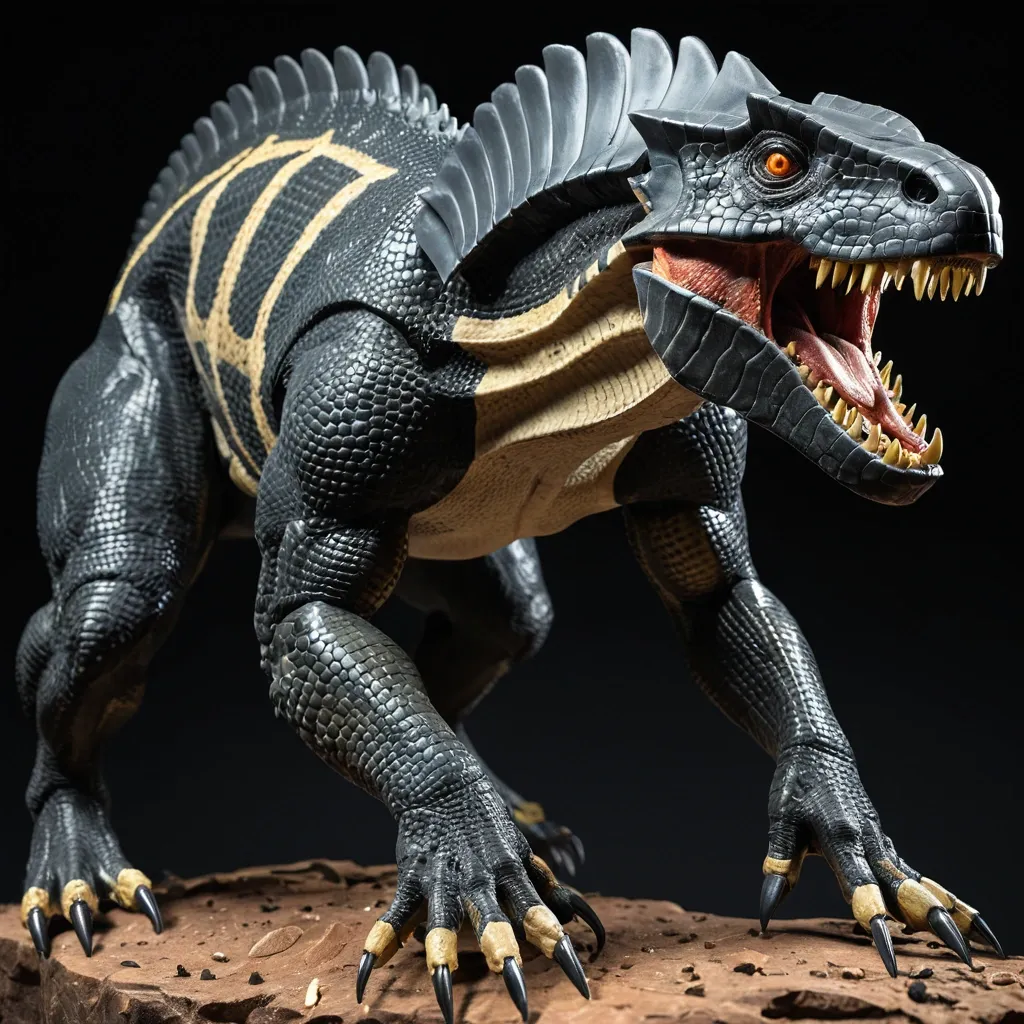
Physical Characteristics: Size & Build: Towering at around 15 feet tall and 40 feet long , Venenosus Rex exhibits a robust , muscular build with bulky , reduced hind legs adapted for powerful knuckle-walking quadrupedal locomotion , inherited from its Ape DNA. Its stance is low and intimidating , allowing swift bursts of speed and stability. Head: The head is a terrifying blend of Tyrannosaurus rex , Giganotosaurus , and Triceratops shapes—a broad , armored skull with a reinforced bony frill and horn-like protrusions from Triceratops , providing natural defense. Its jaw can open up to 90 degrees , snake-like , capable of delivering crushing bites able to shatter bulletproof glass. Skin & Camouflage: Covered in thick , overlapping Scelidosaurus-like osteoderm armor plates along the back and flanks , providing excellent protection against attacks. The skin contains chromatophore cells from cuttlefish DNA , allowing Venenosus Rex to dynamically change skin color , texture , and pattern for camouflage or intimidation. Arms & Claws: Long , powerful arms inspired by Saurophaganax and Ape DNA end in razor-sharp , hooked claws capable of slashing through armored prey and wielding tools for complex hunting strategies. Teeth & Fangs: Teeth are a deadly combination from the Inland Taipan’s retractable fangs , Komodo Dragon’s serrated teeth , and Northern short-tailed shrew’s sharp incisors , allowing it to pierce armor and inject highly toxic saliva into prey. Eyes & Senses: Equipped with specialized cranial cavities housing infrared vision , enabling night hunting and detection of body heat signatures. Its olfactory and auditory senses are exceptionally refined due to Utahraptor and Komodo Dragon ancestry. Unique Abilities: Extreme Environmental Resistance: Thanks to Tardigrade , Opossum , and Mongoose DNA , Venenosus Rex can survive extreme temperatures , radiation , dehydration , starvation , and bacterial infections. Its organs are shielded by trehalose gel , and its DNA is protected by specialized proteins against radiation damage. It can slow its metabolism down to 0.01% of normal , entering a near-hibernative state during harsh conditions. Toxic Saliva & Venom: Its saliva contains potent neurotoxins and anticoagulants , ensuring even minor bites are deadly over time. Combined with its retractable fangs , it can efficiently incapacitate prey or rivals. Camouflage & Stealth: Dynamic skin color and texture changes allow it to blend seamlessly into diverse environments or mimic threatening patterns to intimidate. Intelligence & Pack Hunting: Enhanced Utahraptor DNA grants high cognitive abilities , including planning , problem-solving , and social pack hunting tactics , making it a highly strategic predator. Tool Use: The combination of long , dexterous arms and ape DNA allows it to manipulate objects , set traps , or use environmental tools during hunts. Wide Jaw Opening: The ability to open its jaw at a 90-degree angle allows for impressive bite range and prey handling , intimidating foes with sudden wide gapes. ,
